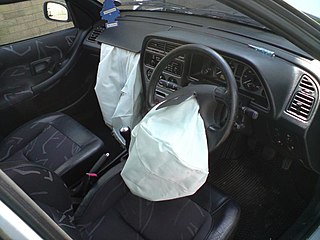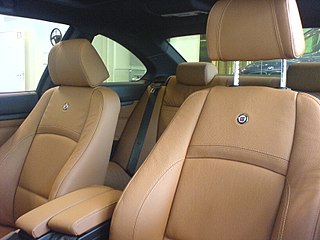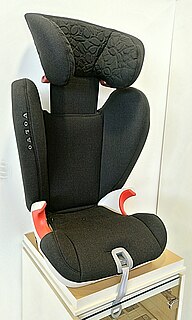Related Research Articles

A seat belt is a vehicle safety device designed to secure the driver or a passenger of a vehicle against harmful movement that may result during a collision or a sudden stop. A seat belt reduces the likelihood of death or serious injury in a traffic collision by reducing the force of secondary impacts with interior strike hazards, by keeping occupants positioned correctly for maximum effectiveness of the airbag, and by preventing occupants being ejected from the vehicle in a crash or if the vehicle rolls over.

An airbag is a vehicle occupant-restraint system using a bag designed to inflate extremely quickly, then quickly deflate during a collision. It consists of the airbag cushion, a flexible fabric bag, an inflation module, and an impact sensor. The purpose of the airbag is to provide a vehicle occupant with a soft cushioning and restraint during a collision. It can reduce injuries between the flailing occupant and the interior of the vehicle.

A crash test is a form of destructive testing usually performed in order to ensure safe design standards in crashworthiness and crash compatibility for various modes of transportation or related systems and components.

Automotive safety is the study and practice of design, construction, equipment and regulation to minimize the occurrence and consequences of traffic collisions involving motor vehicles. Road traffic safety more broadly includes roadway design.

A bumper is a structure attached to or integrated with the front and rear ends of a motor vehicle, to absorb impact in a minor collision, ideally minimizing repair costs. Stiff metal bumpers appeared on automobiles as early as 1904 that had a mainly ornamental function. Numerous developments, improvements in materials and technologies, as well as greater focus on functionality for protecting vehicle components and improving safety have changed bumpers over the years. Bumpers ideally minimize height mismatches between vehicles and protect pedestrians from injury. Regulatory measures have been enacted to reduce vehicle repair costs and, more recently, impact on pedestrians.

A school bus is any type of bus owned, leased, contracted to, or operated by a school or school district. It is regularly used to transport students to and from school or school-related activities, but not including a charter bus or transit bus. Various configurations of school buses are used worldwide; the most iconic examples are the yellow school buses of the United States and Canada which are also found in other parts of the world.

A car seat is the seat used in automobiles. Most car seats are made from inexpensive but durable material in order to withstand prolonged use. The most common material is polyester.
Seat belt legislation requires the fitting of seat belts to motor vehicles and the wearing of seat belts by motor vehicle occupants to be mandatory. Laws requiring the fitting of seat belts to cars have in some cases been followed by laws mandating their use, with the effect that thousands of deaths on the road have been prevented. Different laws apply in different countries to the wearing of seat belts.
The National Highway Traffic Safety Administration is an agency of the U.S. federal government, part of the Department of Transportation. It describes its mission as "Save lives, prevent injuries, reduce vehicle-related crashes" related to transportation safety in the United States.

The National Traffic and Motor Vehicle Safety Act was enacted in the United States in 1966 to empower the federal government to set and administer new safety standards for motor vehicles and road traffic safety. The Act was the first mandatory federal safety standards for motor vehicles. The Act created the National Highway Safety Bureau. The Act was one of a number of initiatives by the government in response to increasing number of cars and associated fatalities and injuries on the road following a period when the number of people killed on the road had increased 6-fold and the number of vehicles was up 11-fold since 1925. The reduction of the rate of death attributable to motor-vehicle crashes in the United States represents the successful public health response to a great technologic advance of the 20th century—the motorization of America.

A child safety seat, sometimes called a infant safety seat, child restraint system, child seat, baby seat, car seat, or a booster seat, is a seat designed specifically to protect children from injury or death during vehicle collisions. Most commonly these seats are purchased and installed by car owners, but car manufacturers may integrate them directly into their vehicle's design and generally are required to provide anchors and ensure seat belt compatibility. Many jurisdictions require children defined by age, weight, and/or height to use a government-approved child safety seat when riding in a vehicle. Child safety seats provide passive restraints and must be properly used to be effective. However, research indicates that many child safety restraints are often not installed or used properly. To tackle this negative trend, health officials and child safety experts produce child safety videos to teach proper car seat installation to parents and caregivers.

Head restraints are an automotive safety feature, attached or integrated into the top of each seat to limit the rearward movement of the adult occupant's head, relative to the torso, in a collision — to prevent or mitigate whiplash or injury to the cervical vertebrae. Since their mandatory introduction in some countries beginning in the late 1960s, head restraints have prevented or mitigated thousands of serious injuries.
Vehicle regulations are requirements that automobiles must satisfy in order to be approved for sale or use in a particular country or region. They are usually mandated by legislation, and administered by a government body. The regulations concern aspects such as lighting, controls, crashworthiness, environment protection and theft protection, and might include safety belts or automated features.
Government regulation in the automotive industry directly affects the way cars look, how their components are designed, the safety features that are included, and the overall performance of any given vehicle. As a result, these regulations also have a significant effect on the automotive business by generally increasing production costs while also placing limitations on how cars are sold and marketed. Automotive regulations are designed to benefit the consumer and protect the environment, and automakers can face stiff fines and other penalties if they are not followed.

Most seat belt laws in the United States are left to the states and territories. However, the first seat belt law was a federal law, Title 49 of the United States Code, Chapter 301, Motor Safety Standard, which took effect on January 1, 1968, that required all vehicles to be fitted with seat belts in all designated seating positions. This law has since been modified to require three-point seat belts in outboard-seating positions, and finally three-point seat belts in all seating positions. Initially, seat belt use was voluntary. New York was the first state to pass a law which required vehicle occupants to wear seat belts, a law that came into effect on December 1, 1984. New Hampshire is the only state that has no enforceable laws for the wearing of seat belts in a vehicle.
The Federal Motor Vehicle Safety Standards (FMVSS) are U.S. federal vehicle regulations specifying design, construction, performance, and durability requirements for motor vehicles and regulated automobile safety-related components, systems, and design features. They are the U.S. counterpart to the UN Regulations developed by the World Forum for Harmonization of Vehicle Regulations and recognized to varying degree by most countries except the United States. Canada has a system of analogous rules called the Canada Motor Vehicle Safety Standards (CMVSS), which overlap substantially but not completely in content and structure with the FMVSS. The FMVSS/CMVSS requirements differ significantly from the international UN requirements, so private import of foreign vehicles not originally manufactured to North American specifications is difficult or impossible.
When a person makes a claim for personal injury damages that have resulted from the presence of a defective automobile or component of an automobile, that person asserts a product liability claim. That claim may be against the automobile's manufacturer, the manufacturer of a component part or system, or both, as well as potentially being raised against companies that distributed, sold or installed the part or system that is alleged to be defective.
The BeSeatSmart Program is a federal grant-based program supported by the Governor's Highway Safety Program, Vermont, and hosted by The Vermont Department of Health. BeSeatSmart provides child passenger safety seats, hands on help, advice, consultations, presentations, training, materials and support to residents of Vermont. BeSeatSmart provides best practice advice as given and sourced by the American Academy of Pediatrics (AAP) and the National Highway Traffic Safety Administration (NHTSA).
Williamson v. Mazda Motor of America, Inc., 562 U.S. 323 (2011), was a decision by the Supreme Court of the United States, in which the Court unanimously held that Federal Motor Vehicle Safety Standard 208, promulgated by the National Highway Traffic Safety Administration, does not federally preempt state tort lawsuits against auto manufacturers from injuries caused by a defective lack of certain types of seat belts.
Federal Motor Vehicle Safety Standard 116 regulates motor vehicle brake fluids in the United States. Like all other Federal Motor Vehicle Safety Standards, FMVSS 116 is administered by the United States Department of Transportation's National Highway Traffic Safety Administration.
Federal Motor Vehicle Safety Standard 106 regulates motor vehicle brake hoses and related assemblies and fittings in the United States. Like all other Federal Motor Vehicle Safety Standards, FMVSS 106 is administered by the United States Department of Transportation's National Highway Traffic Safety Administration.
References
- ↑ "Federal Motor Vehicle Safety Standards and Regulations". www.nhtsa.gov. Archived from the original on 2005-01-11.